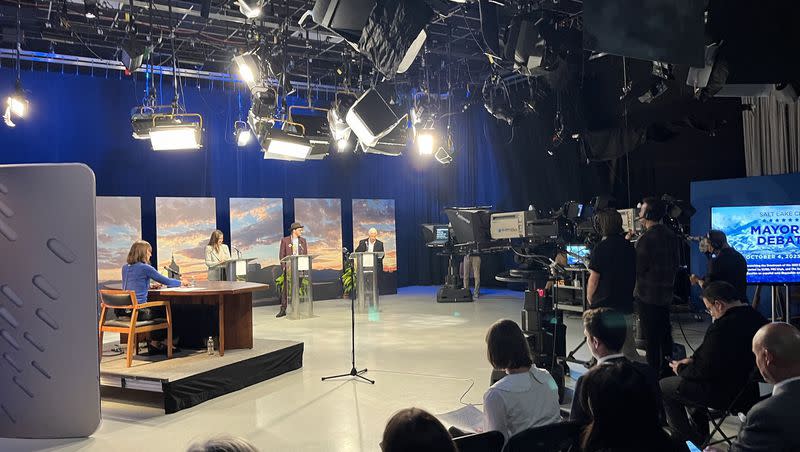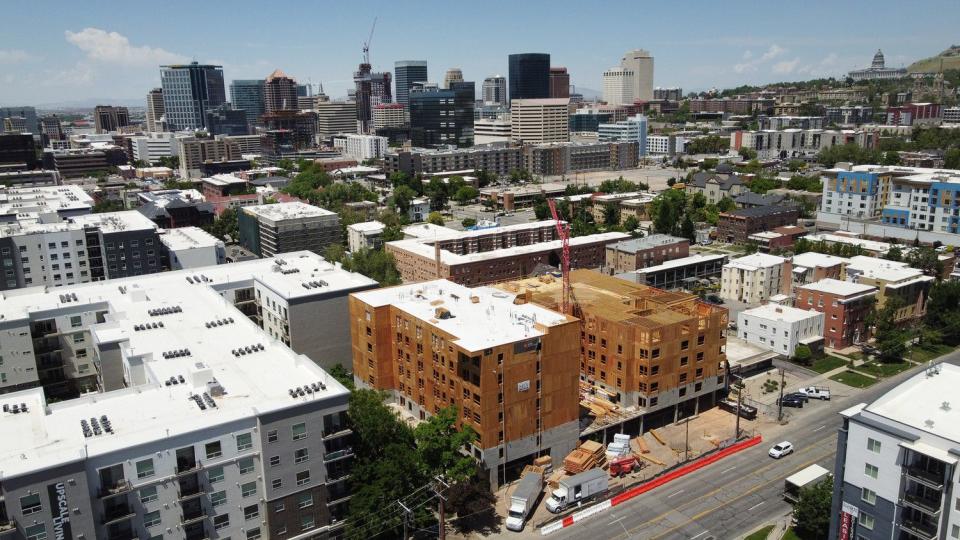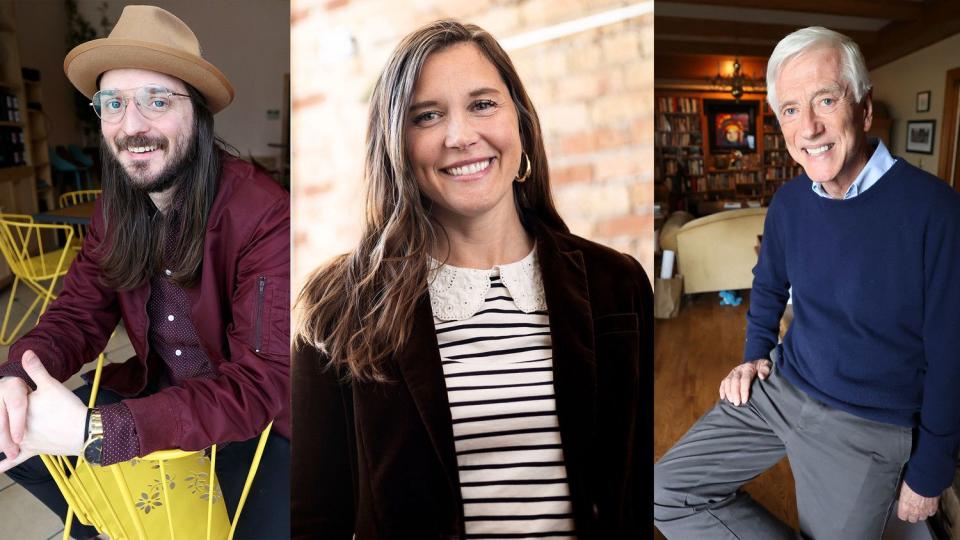5 takeaways from Salt Lake City's televised mayoral debate

- Oops!Something went wrong.Please try again later.
- Oops!Something went wrong.Please try again later.
As this year's first televised Salt Lake City mayoral debate came to an end Wednesday evening, three candidates seeking the job were asked about the direction of the city moving forward and their answers could have very well summed up the night, or even the race to this point.
Salt Lake City — now the most populated it has been — is heading in the right direction, Salt Lake City Mayor Erin Mendenhall said. She spent the evening pointing to other successes, such as downtown's strong post-COVID-19 recovery.
"We are not perfect, but we are pretty great," she added moments later.
However, her challengers — former Salt Lake City Mayor Rocky Anderson and community activist Michael Valentine — disagreed, often pointing to challenges with housing affordability and homelessness throughout the night, as they argued a case for why voters should consider them.
"We've been headed in the wrong direction for a long time, but it can be turned around to where it is the best city to live in North America," Anderson said.
The hourlong 2023 Salt Lake City Mayoral Debate, hosted by PBS Utah, KUER and the Salt Lake Tribune, meandered through several different issues ahead of the Nov. 21 election. Here are four other takeaways from the event:
Housing affordability
The cost of living in Salt Lake City remains on the rise, which isn't necessarily different from other communities across Utah. State housing officials estimated earlier this year that Utah is short more than 40,000 units for people making 50% of the average median income.
Anderson said he believes Salt Lake City's situation has reached a "crisis level." He proposed that the city should oversee future affordable housing developments like other cities have done across the globe as a "public good" similar to libraries or streets, where the city is able to control the housing cost.
Valentine seemed to agree with Anderson on the issue, asserting that the current administration is "subsidizing luxury housing and calling it affordable housing," and arguing it's behind rising costs.
"(It's) increasing unaffordability, driving people into homelessness and driving people out of the city through gentrification," he said. "What we need to do is use public money for the community, not for real estate investors and developers."

The city invested about $55 million toward affordable housing in the past 3½ years, resulting in about 4,000 units, Mendenhall said.
She insists that working with developers and other partners allows for the city to chip away at its large housing deficit faster, saying it would cost the city 18 times more to build developments alone and eight times more to cover retrofit projects.
"My administration has invested more than every other mayoral administration combined in affordable housing," she said.
Homelessness
The number of people experiencing homelessness is also on the rise. Utah's 2023 Point-in-Time count report found more than 3,500 Utahns were experiencing homelessness at the time of its annual count, up 3.7% from the previous year.
Mendenhall, who has long said the issue is split between the city, state and county, said programs to provide aid are working for many, even if not for everyone. In Salt Lake County from 2020 to 2022, about 70% of those who ended up in the homeless resource center system eventually left the system, having their housing situation resolved either through permanent or temporary housing.
She said the city has about 577 supportive units for people experiencing homelessness, either built, under construction or in the pipeline, down about 200 units after a deal with the Ramada Inn recently fell through.
Anderson dinged the mayor on this, even before the debate. He held a press conference Tuesday, where he questioned Mendenhall's initial figures and whether the projects will be completed in time for this winter. In addition to the Ramada Inn deal collapse, Anderson said the mayor is using stats that should be credited to the previous administration.
Overall, he says he doesn't believe the city is equipped to handle the situation, which he fears may result in more deaths and injuries as was the case this past winter.
"It's important that our mayor be straight with the people of the city, especially about matters of life and death and the quality of life for everybody," he said.
Valentine said he would declare a state of emergency over the issue and set up a sanctioned camp before getting unsheltered residents into housing — an approach similar to what he said others are taking across the world.
"To me, success is nobody on the streets anymore," he said.
Salt Lake City's relationship with Utah
It's no secret Salt Lake City is an outlier when it comes to Utah politics, where Democrats outnumber Republicans. This has pitted city leaders against state leaders on several issues over the years.
All three candidates were asked about how they would handle these types of relationships. Valentine, the only candidate who hasn't sat in the mayoral seat, said his campaign is drawing support over different political spectrums from both parties.
"I'm trying to unite people from all backgrounds and boundaries, and I think I've been very successful with that," he said.
The other two candidates have had different experiences with the job when it comes to dealing with state leaders, which they used against each other during one of the more contested moments of the night.
Mendenhall touted her abilities to work with Republican lawmakers and Gov. Spencer Cox on issues, which she says is helping the city avoid being in the "legislative washing machine every year."
"We've had too many mayors, including one on this stage tonight, who made it a point of burning more bridges than they were building," she said. "Those bridges have needed rebuilding — we have seen it."
Anderson countered by calling the idea that he can't work with legislators "absolutely absurd." He said he has worked with plenty of people from different political backgrounds over his career, even if his approach has ruffled feathers in the past.
"We have a mayor who just wants to have a place at the table all the time," he said. "People are looking for leadership that will stand up on principle."

The Great Salt Lake
The Great Salt Lake's decline over the past two decades, including its all-time low last year, continues to make global headlines, especially as Utah's capital city becomes more vulnerable to environmental impacts now and in the future.
All three candidates expressed concern about the lake on Wednesday, voicing concerns over alfalfa farming and mineral extracting happening outside of city boundaries.
Valentine said he supports a recent lawsuit against state agencies over the lake's health and that he would work with other cities to find solutions.
"I'd be a voice for the city, for the rest of Utah, to push for the state and the federal government to see some real change," he said.
When it comes to the lake and water conservation, Anderson said he believes the city should move away from having any turf requirements, and make it easier for residents to have more water-wise lawns.
The city is helping to improve water conservation, sending 13 billion gallons of treated water to the lake, Mendenhall said. Salt Lake City water users also used 2.9 billion gallons of water less during the 2022 irrigation season and preliminary estimates show even less water was used again this year.
"We're doing quite a lot," she said, "and we're going to keep finding new ways to do more."

